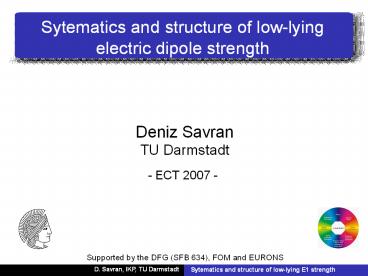Sytematics and structure of low-lying electric dipole strength - PowerPoint PPT Presentation
1 / 29
Title:
Sytematics and structure of low-lying electric dipole strength
Description:
High selectivity to dipole excitations. Well known excitation mechanism ... and structure of low-lying E1 strength. D. Savran, IKP, TU Darmstadt. Selectivity ... – PowerPoint PPT presentation
Number of Views:53
Avg rating:3.0/5.0
Title: Sytematics and structure of low-lying electric dipole strength
1
Sytematics and structure of low-lying electric
dipole strength
Deniz Savran TU Darmstadt
- ECT 2007 -
Supported by the DFG (SFB 634), FOM and EURONS
2
Outline
- Introduction
- Systematic studies using the (?,?) method
- The PDR in ? scattering experiments
- Method (?,??) coincidence experiments
- Results 140Ce(????)
- Outlook
- NEPTUN at S-DALINAC
3
Electric dipole strength in atomic nuclei
?
- Giant Dipole Resonance (GDR)
- Pygmy Dipole Resonance (PDR)
4
Experiments with real photons
- High selectivity to dipole excitations
- Well known excitation mechanism
Photodissociation (g,n), (g,p),
Photon scattering (g,g)
5
Photon scattering (???) at the S-DALINAC
Radiator
Target
e-
Sn
6
136Xe(?,?)
E0 9.1 MeV
7
136Xe(?,?)
E0 9.1 MeV
N?(E?) ?(E?)
8
136Xe(?,?)
E0 9.1 MeV
9
E1 strength in stable N82 isotones
(?,?) _at_ S-DALINAC
- Strong fragmentation
- Concentration around 5.5 - 7.0 MeV
- Scaling with N/Z
A. Zilges et al., Phys. Lett. B 542 (2002) 43 S.
Volz et al., Nucl. Phys. A779 (2006) 1
10
Summed B(E1) strength (up to Sn)
N82
Z50
(preliminary)
(preliminary)
A. Zilges et al., Phys. Lett. B 542 (2002) 43 S.
Volz et al., Nucl. Phys. A779 (2006) 1
K. Govaert et al., Phys. Rev. C 57 (1998) 2229 B.
Özel et al., Nucl. Phys. A788 (2007) 385 N.
Tsoneva et al., Nucl. Phys. A731 (2004) 273
11
PDR - Theory
Different approaches reproduce the gross features
of the available photoresponse data.
But interpretation partly different
- Neutron skin
- Toroidal mode
- Cluster effects
- ...
Photoresponse not enough !
12
?-particles vs. photons (macroscopic)
????? (strong interaction)
(???) (EM interaction)
E0,E1,E2,E3
E1,M1,(E2)
multipolarity
isoscalar
isovector
isospin
surface peaked
whole nucleus (kR 1)
location
30-100 keV (straggling)
7-10 keV
energy resolution (_at_ EX 8 MeV)
130 MeV and forward angle
? New structure information
? Important for spectroscopy of PDR
13
Why (?,??) coincidence experiments ?
- Problems in (???)
- Separation from other excitations
- Resolving of single excitations
- Coincident ?-decay detection
- Selection of decays to the ground state
- ? Selectivity to E1
- HPGe detectors
- ? Very high energy resolution
T.D. Poelhekken et al., Phys. Lett. B 278 (1992)
423
D. Savran et al., Nucl. Instr. and Meth. A 564
(2006) 267
14
High resolution ?-spectroscopy at the BBS _at_ KVI
Big-Bite-Spectrometer (BBS)
EX E? - E?
?? ? 9 msr
Target
E?
? Absolute photopeak efficiency 0.5 at 1.33
MeV
HPGe detectors
D.Savran et al., Nucl. Instr. and Meth. A 564
(2006) 267
15
140Ce(????) - coincidence matrix
E? 136 MeV ?? 3.5
Sn(140Ce)
16
Selectivity
?-? coincidence matrix
x-projection (?-spectrum)
y-projection (?-spectrum)
17
140Ce(????) - decays to the groundstate (E??EX)
- Very low background
- Energy resolution
- ?E 10 keV
- ? state-to-state analysis
- Multipole assignments by angular distribution
- High selectivity to E1 excitations
18
140Ce(????) vs. 140Ce(???)
D.Savran et al., Phys. Rev. Lett. 97 (2006) 172502
19
140Ce(????) vs. 140Ce(???)
Splitting of the PDR into two parts with
different underlying structure ?
D.Savran et al., Phys. Rev. Lett. 97 (2006) 172502
20
B(E1) in 140Ce
Convolution with Lorentz function (F. Iachello)
21
B(E1) in the N82 isotones und Z50 isotopes
K. Govaert et al., Phys. Rev. C 57 (1998) 2229 B.
Özel et al., Nucl. Phys. A788 (2007) 385
A. Zilges et al., Phys. Lett. B 542 (2002) 43 S.
Volz et al., Nucl. Phys. A779 (2006) 1
22
138Ba(????)
23
Summary
- Systematics of the PDR studied in (?,?)
experiments - Results of 140Ce(????) and 138Ba(????) point to
a splitting of the PDR - Low energy part excited in (?,??) and (?,?)
- High energy part excited in (?,?) only
- Two modes with different underlying structure?
24
Experiments with real photons
Photodissociation (g,n), (g,p),
Photon scattering (g,g)
25
NEPTUN _at_ S-DALINAC
- Energy range
- E? 6-15 MeV
- High Resolution
- (?E 25 keV)
- High Intensity
- (103 ? / keV s cm2)
- Complete Photoresponse (?,?),(?,p),(?,n),(?,?)
- Detailed decay patterns
26
Decay patterns up to Sn
Sn
E?
NEPTUN - Excitation energy
E?
- ?-spectroscopy
- ??-decay energy
AX
27
Decay patterns above Sn
En
Sn
A-1X
E?
NEPTUN - Excitation energy
E?
?-spectroscopy - ?-decay energy
AX
Time-of-flight - Neutron energy
28
Collaboration
M. Fritzsche, J. Hasper, K. Lindenberg, L.
Schnorrenberger, S. Müller, K. Sonnabend, S.
Volz, (Institut für Kernphysik, TU Darmstadt)
M. Elvers, J. Endres, A. Zilges (Institut für
Kernphysik, University of Cologne)
- A.M. van den Berg, P. Dendooven,
- A. Matic, M.N. Harakeh, H.J. Wörtche
- (KVI, Groningen)
supported by the DFG (SFB 634), FOM and EURONS
29
(No Transcript)































